NorthEast Radio Watch 12/15/2025: NYC Morning Shakeup
In this week’s issue… NYC morning shows exit - Carton back amidst WFAN shakeup - FM signing off in Canada - More radio centennials
Text and photos by SCOTT FYBUSH
We were only there for a couple of days in September 2019, but we sure did fall hard for the chaotic vibrancy that is Houston. There’s so much more we hope to see in depth, and we’d probably have headed back this year if not for… well, you know.
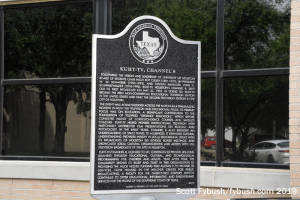
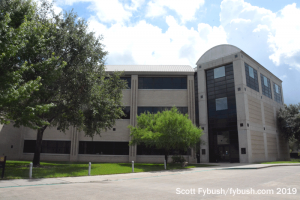
For instance: did you know that the very first educational TV station in the country was right here in Houston? KUHT (Channel 8) signed on May 25, 1953 from studios in Cullen Hall at the University of Houston, many months ahead of other famous early ETV callsigns such as WQED in Pittsburgh and WGBH in Boston.
Over the years, KUHT moved its facilities several times: its transmitter was already on the tower behind the TV studio building on Cullen Boulevard on the south edge of the UH campus, but that building was rented out to commercial tenants for its first decade, initially to KNUZ-TV (Channel 39), then to KTRK (Channel 13) after KNUZ became one of many early UHF failures. Once KTRK built its own showplace facility southwest of downtown in 1964, KUHT moved in on Cullen Boulevard and stayed there until 2000, when it and its radio sister, KUHF (88.7), moved to a new custom-built building on the north edge of campus off I-45.
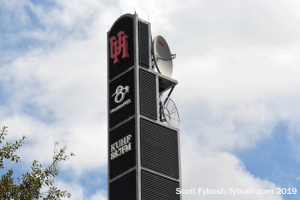
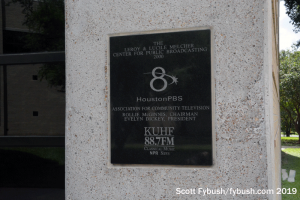
The history moved with KUHT: there’s a plaque here at the newer building marking channel 8’s place in educational TV history, as well as a marker for the 2000 dedication of this facility, the Leroy and Lucile Melcher Center for Public Broadcasting.
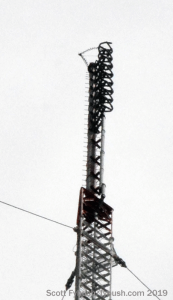
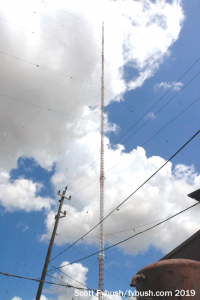
Over the years, a few other signals have come and gone here: for a few years, KUHF spawned an all-classical sister, KUHA (91.7), using a signal it acquired from Trinity University (the former KTRU, now religious KXNG); later, after the devastation of Hurricane Harvey in 2017, CBS affiliate KHOU (Channel 11) moved its studios in here and stayed until it opened its own new digs in 2019.
A couple of miles north of here, in an industrial neighborhood east of downtown near Buffalo Bayou, a narrow driveway off Engelke Street leads back to a tall tower that carries KCOH (1230), KLTN (102.9) and KAMA-FM (104.9 Deer Park). The 1230 signal is the old KNUZ, a big top-40 voice back in the day; it and 102.9 were both later KQUE, before being sold off to separate owners. The 104.9 signal moved in much later, relocating into the heart of Houston from Rosenberg, way out to the southwest.
The FMs are part of Univision now, while the AM signal ended up with the KCOH callsign that was long associated with Black radio in town, up the dial on 1430. (The AM also has – had? – an experimental license for a synchronous transmitter up to the northwest of Houston.)
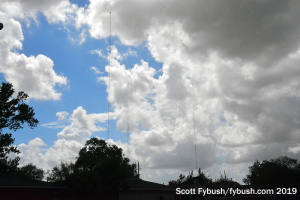
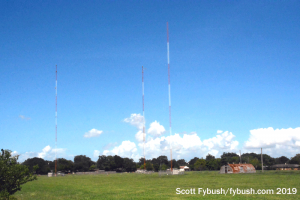
The old KCOH on 1430 is doing Spanish religion these days, as Guadeloupe Radio’s KSHJ; its three-tower array is due east of downtown in the Pleasantville neighborhood, just inside the 610 beltway.
Hop on the beltway, head south across Buffalo Bayou and then east on the Pasadena Freeway, and you’ll arrive in Pasadena, the big suburb southeast of Houston. There’s lots of broadcast history specific to Pasadena, going back to 1950 and the debut of KLVL on 1480. The address has changed a few times over the years, but the site on Pasadena Boulevard, Quonset hut and all, hasn’t – these three towers have carried KLVL in a variety of formats, most recently leased-time ethnic, for 70 years now. (The tall tower also carried the old KLVL-FM 92.5, which eventually became today’s KKBQ 92.9, still licensed to Pasadena but transmitting from Missouri City with the other big Houston FMs.)
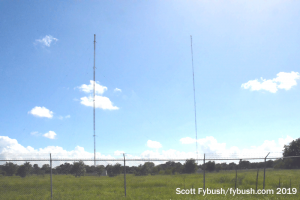
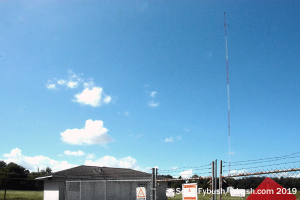
There’s actually even older broadcast history here, a couple of miles north along the south frontage road of the Pasadena Freeway. The frontage road is the old Highway 225, and it was back in 1943 that one of Houston’s oldest stations, KXYZ, moved its transmitter way out here from downtown, changing frequency from 1470 to 1320.
KXYZ’s move, which created the space on the dial KLVL would fill a few years later, actually brought it to a site and a frequency that had been in use here even longer. When the University of Texas sold the original KUT in 1930 and its new owners brought it to Houston as KTRH, it put its transmitter at this site, in what was then described as “Deepwater, Texas.”
Originally on 1330, KTRH moved to 1290 in 1935, then to 1320 in the NARBA shuffle of 1941 – and by then, KXYZ had already applied to take over the former KTRH facilities, which it did right after KTRH moved to 740 and across San Jacinto Bay to Cedar Bayou. (We didn’t get to that historic KTRH site on this trip, nor to KTRH’s current site in Baytown, thanks to storm damage that made it inaccessible.)
These days, KXYZ is a low-profile player on the Houston dial, running leased-time programming under Multicultural Broadcasting, but at one time it was a much bigger force in Houston radio, owned by ABC in the 1960s and 1970s. (It was a sister station, in fact, to WXYZ in Detroit, another venerable station with roots back to the 1920s.)
One more AM signal also has a long history in Pasadena: a couple of miles east of KLVL, KIKK (650) has a pretty big signal for a 250-watt daytimer, carrying CBS Sports Radio all over the greater Houston area from its site at the end of Crestwood Lane. This big little station started in 1946 in Baytown as KRCT, then moved to Pasadena in 1957, initially diplexing with KXYZ until it built this site for itself in 1965.
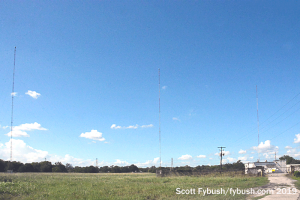
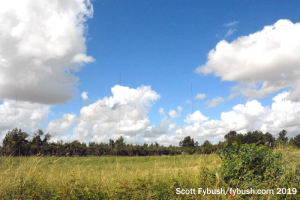
All done with Pasadena? Good – because there’s more to see on the north side of Houston, starting just outside the I-610 loop at its northeast corner. It’s a good thing we stopped by the three-tower site of KPRC (950) off Liberty Road, because it will be gone soon.
KPRC, now an iHeart sister station to KTRH and KBME (790), is the oldest AM in Houston itself, with roots back to 1925. The Houston Printing Company moved the station several times, first way out to the southwest in Sugar Land, then in 1936 to a diplex on KTRH’s site in Deepwater, where it remained after KTRH moved out and KXYZ moved in. In 1957, KPRC moved back to Houston, making room at the Deepwater site for KIKK. KPRC built a new DA behind the new studio building for KPRC radio and KPRC-TV 2 on Post Oak Road – but it didn’t stay long. When construction of the 610 loop displaced KPRC in 1964, 950 moved up here to the opposite corner of 610.
After iHeart sold its transmitter sites to Vertical Bridge, the tower company started looking at the underlying value of some of those pieces of land – and so it’s unloading this property, with KPRC holding a CP to move sometime soon to a diplex a few miles to the northwest, on four of the eight towers of sister station KBME (790).
KBME is the descendant of KTHT, which started in 1944 on 1230. Judge Roy Hofheinz, the dynamo who later started the Colt .45s/Astros, built the Astrodome and was a part-owner of KTRK-TV, was the founder of KTHT, and he dreamed big: by 1948, he’d moved KTHT to 790 (and arranged for friendly “competitors” to take over the 1230 signal as a new license, KNUZ), and he applied to go 50 kW on 1030, too, though the FCC didn’t grant that one.
(Where was that original KTHT 1230 site? Why, it’s the same location we showed you near the beginning, where the later KNUZ/KQUE/KCOH 1230 have been all along.)
On 790, KTHT cycled through several owners and formats, becoming KULF, then KKBQ, a sister station to KKBQ-FM (descendant of the old KLVL-FM in Pasadena.)
By then, the 790 site had moved: when Hofheinz relocated it to 790 in 1948, it was out in what’s now Deer Park, just northeast of Pasadena. In 1974, it traded that four-tower site for an eight-tower site north of Houston near I-45, not far from the KILT (610) towers we showed you a few installments back. And don’t go looking for any signs of 790 at the old Deer Park site – it’s now a big chemical plant, in keeping with what’s become a huge sprawl of refineries east of Houston out to Trinity Bay and the Gulf.
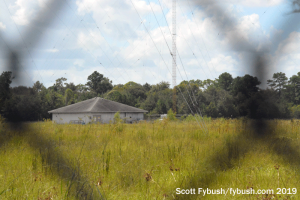
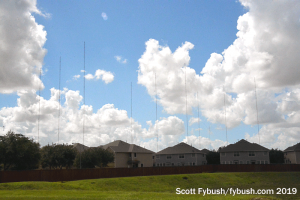
Today’s metro Houston stretches for miles and miles to the north, up the I-45 corridor into Spring and the Woodlands and Conroe, and while we didn’t get up to all the AMs up here, there was one we absolutely weren’t going to miss.
Salem’s KNTH (1070) boasts a record, as far as we’re aware: add up its nine 152-meter towers (used both day and night) and the two 70-meter towers that are part of its 11-tower day pattern, and you get a whopping 4551 feet of steel in the air at this site north of the Sam Houston Tollway and west of I-45!
It took a while to squeeze this one into a crowded dial: the initial application for 1070 here was filed in 1959, a CP was granted in 1964, but it wasn’t until 1970 that the station signed on as KENR. It was “Keener Country” through most of the 1970s, became the AM sister to KRBE in the 1980s, did Z-Rock for a time as KKZR, and eventually separated from KRBE, first with a return to the KENR calls and then with Salem’s talk format as KNTH. It has a translator up here now, too, on 103.3.

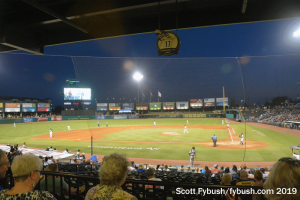
There’s a lot more up here that we didn’t get to see: the even newer high-power AM in Tomball, KSEV (700); the old Houston AM signal on 1590, long KYOK and now KMIC; and so much more.
But we did at least get to one more baseball game before leaving Houston. Out to the southwest in Sugar Land, the Skeeters put on a good show in modern minor-league fashion, at a well-attended park complete with a splash park and a swimming pool in the outfield. They were an independent team when we visited in 2019, and one of the few minor-league teams to play in front of live crowds in 2020. In 2021, they’ll apparently join the organized minor-league system at the AAA level.

As we announced a few weeks ago, the 2026 edition of the Tower Site Calendar will be the last.
We began publishing it 25 years ago, and the broadcast landscape is radically different now.
Radio World just ran an excellent article about us if you want to know more.
Once it’s gone, that’s it. We won’t be printing any more.
Thank you to everyone who saw our announcement and rushed to buy it. We appreciate you.
(There are some calendars from previous years if you want more of a tower photo fix — all under $5.)
But don’t wait to get this year’s Tower Site Calendar — buy it now!
We are selling the Broadcast Historian’s Calendar again this year, but we have that in an even smaller quantity — definitely don’t hesitate for that.
And visit the Fybush Media Store to check out our selection of books and videos, too!
And don’t miss a big batch of Houston IDs next Wednesday, over at our sister site, TopHour.com!
Next week: Bryan and College Station
In this week’s issue… NYC morning shows exit - Carton back amidst WFAN shakeup - FM signing off in Canada - More radio centennials
In this week’s issue… Veteran newsman returns - Remembering NY's Leitner, RI's Jones - CT AM saved - Maine AM moves - "Indie" adds suburban signals
In this week’s issue… Scripps stations face takeover - Sinclair moves more affiliations - CT stations sold - Maine AM surrendered - Remembering WVBR's Shapiro, WABC's Morgan
In this week’s issue… CT TV legend succumbs to cancer - Remembering PA's Adams - FCC still stalled by shutdown - Pittsburgh morning host exits